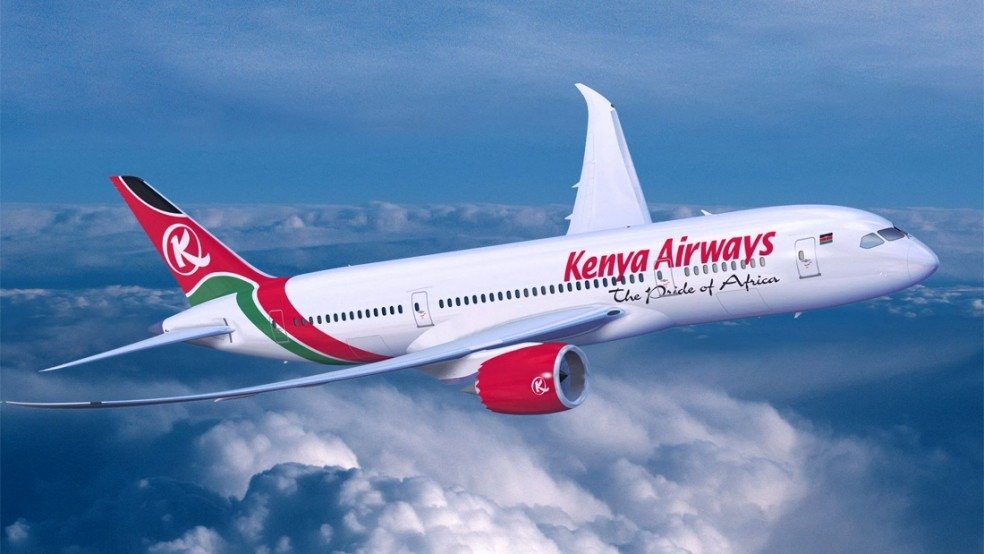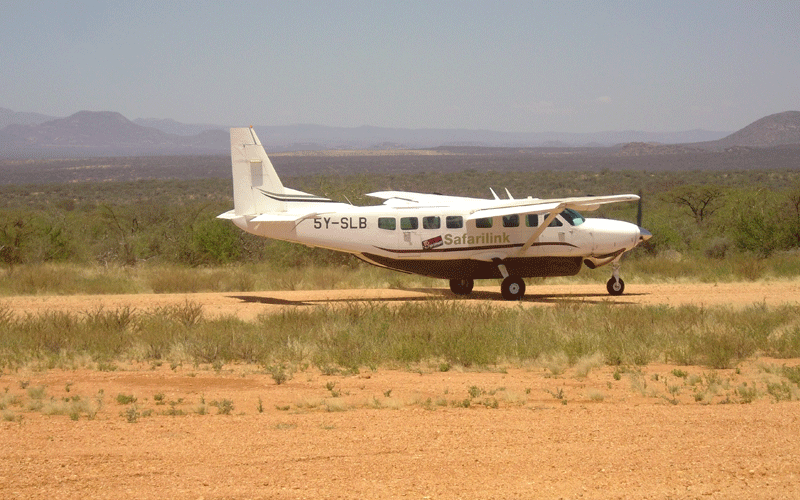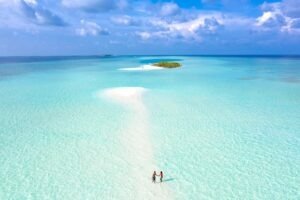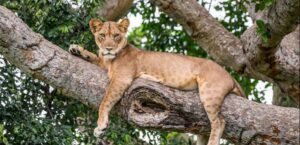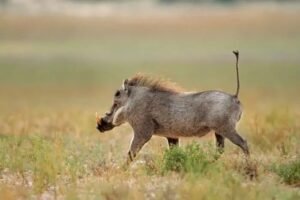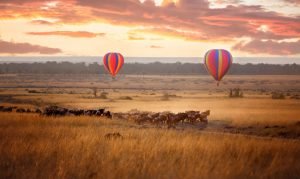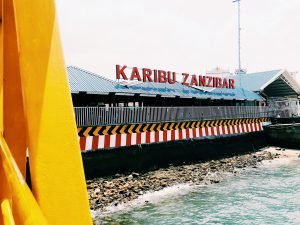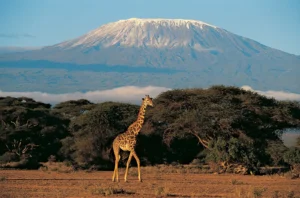
Top reasons on why to go for a Wildlife Safari in Kenya
Why Go for a Wildlife Safari in Kenya, Cultural, Historical Trip & Marine Beach Vacation.
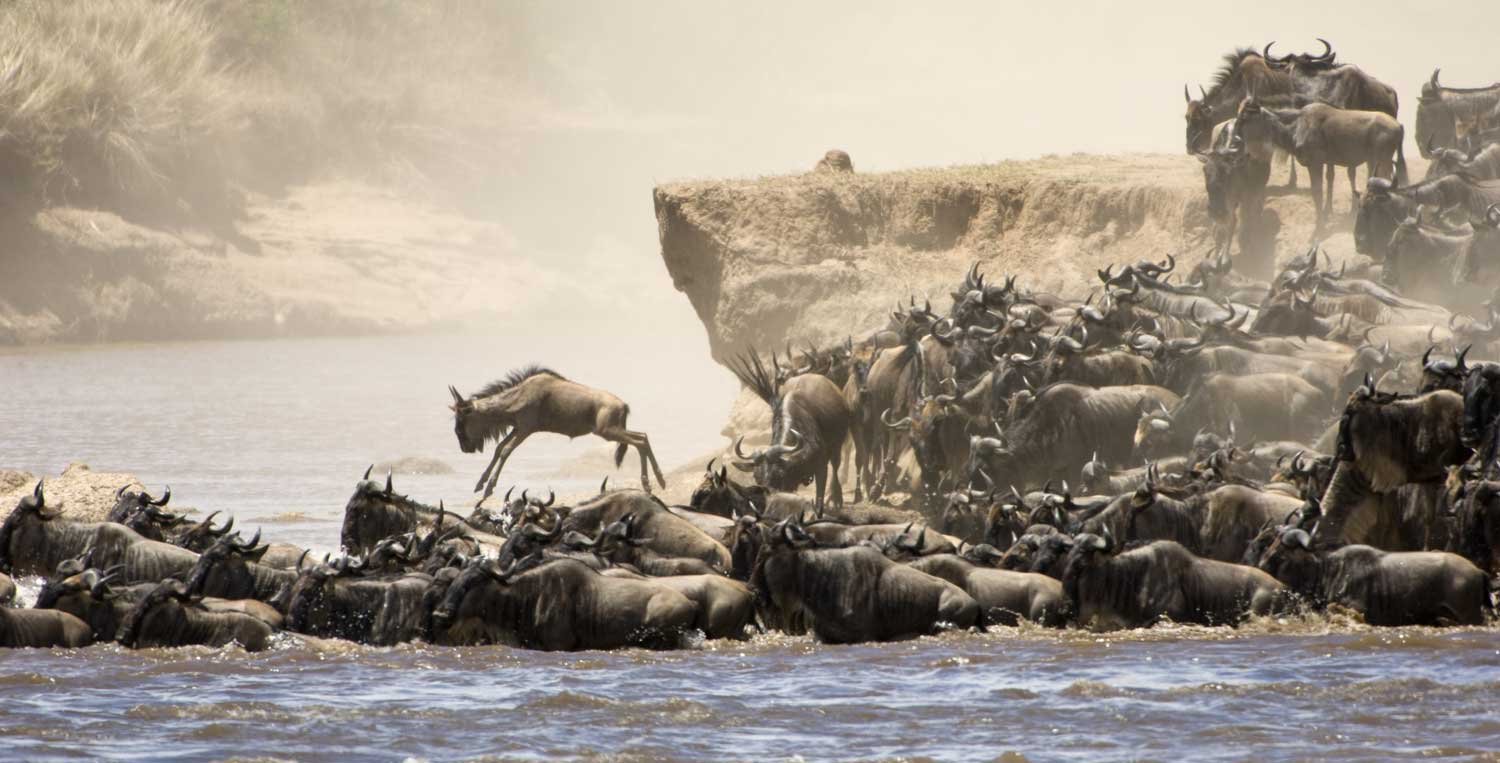
An African safari involves several wildlife game drives, staying in remote locations, and observing the behavior and survival skills of Nature’s inhabitants. You can choose to be electronically unplugged from the modern world (internet is available, but ignored; turned off the cell phone; no newspapers, radio or television), no fast food chain restaurants, no vehicular traffic, no crowds of people, no man-made noises – an alien world in today’s fast-paced, modern hurly burly.
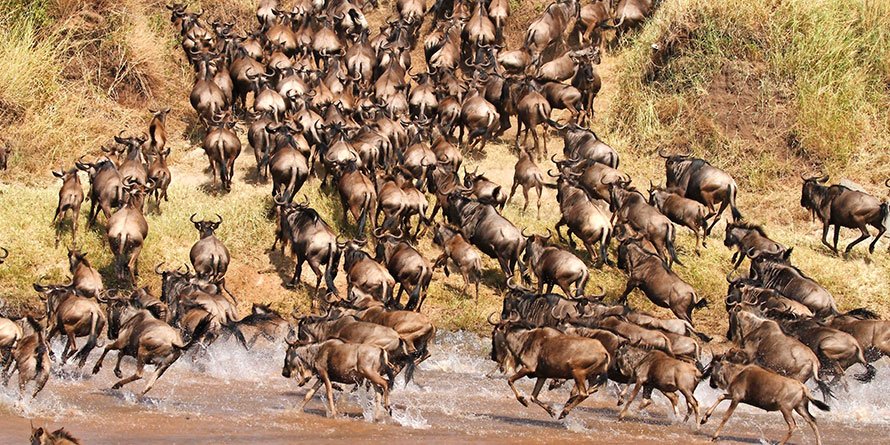
Wildlife Safari in Kenya is one of Africa’s most distinct and stunning locations and your travels with Sima Safari takes you to the country’s finest destinations.
The source of the word “safari” from Swahili and its exact meaning is a journey. The tourists changed the concept and made it into open African parks where you can meet animals in their natural habitat.
View our Classic Safari Packages in Kenya
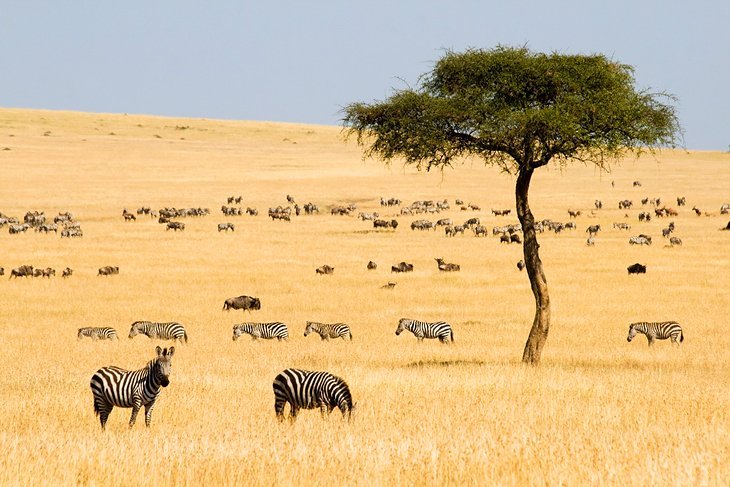
The diversity of game in Kenya is simply astounding. From the big five to the small five, Kenya’s game parks, reserves and other wildlife protection areas host some of the wildest game thus the reason why Wildlife Safari in Kenya is in deed unforgettable.
Dotted in their unique landscapes, geographical features, a vast array of game ensues. The icing of Wildlife Safari in Kenya is the annual Wildebeest Migration at the infamous Maasai Mara migration between mid-July and late October.
This is the best example of wild nature at its best as hundreds of thousands of wildebeests, zebras, Thomson’s gazelles, topi and elands.
Sustainable tourism and a globally-recognized model of wildlife management mean that you see pristine wilderness and internationally-significant habitats where wildlife roams freely, including rare and endangered species and the Big Five. Visit magical Kenya, and experience all that Africa offers.
Kenya’s geography.
Kenya is located in East Africa. Its terrain rises from a low coastal plain on the Indian Ocean to mountains and plateaus (areas of level high ground) at its center.
Most Kenyans live in the highlands, where Nairobi, the capital, sits at an altitude of 1,700 metres.
West of Nairobi the land descends to the Great Rift Valley, a 6,400-kilometre tear in the Earth’s crust. Within this valley in the deserts of northern Kenya are the green waters of famous Lake Turkana.
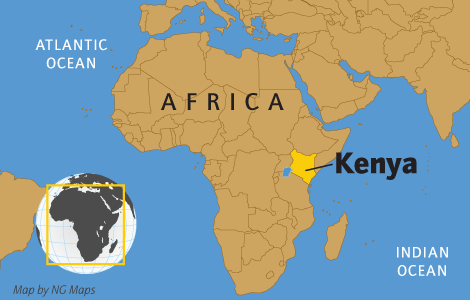
Kenyan people & culture.
In Kenya, more than 60 languages are spoken and there are more than 40 ethnic groups. Almost everyone there speaks more than one African language.
Music and storytelling are important parts of Kenyan culture. For centuries, tribes throughout the country have used songs, stories and poems to pass on their beliefs, history, and customs.
7 DAYS MOUNT KENYA TREK(Chogoria Traverse.)
Security.
Most areas in Kenya are very safe and especially the national parks area and the south beaches of Diani Beach. Kenya is the most traditional touristic nation is East Africa and the experience of the Kenyan in hospitality and welcoming tourist is very well known.
Areas that are in clashes with the Somali borders along the North beaches and the North national parks are area we recommend to avoid these days.
Imagine a straight line from Mombasa to Lake Turkana and all area west of this line are very safe to travel and are the most attractive areas ( see map above)
Kenya is a politically stable, multi-democratic country. As in all countries, a little common sense goes a long way and reasonable precautions should still be taken, such as shocking valuables in the hotel safe and not walking alone at night.
Best Time for Safari
July – October – Great migration is in Masai Mara (other months are also good although great migration is not in Kenya)
Time.
Local: Time is GMT + 3 hours.
Banking.
Banks and bureau de change are available at airports and in all major. Banks hours are from Monday – Friday 8:20am – 3:00pm, Saturday 8:30am – 1:30pm
Currancy value: Kenyan shilling : 1 USD = 106 kes 1Euro = 120 Kes ( correct to June 2020) .
Official Language.
Kiswahili and English
Kenya’s nature.
Millions of people visit Kenya each year to see its endless savannah and the animals that inhabit it: elephants, lions, cheetahs, giraffes, zebras, hippos, rhinos and more. The Kenyan government has set up more than 50 reserves and parks to protect these animals.
People hoping to spot some amazing African wildlife usually focus on Kenya’s lowland savannah. But Kenya’s ecosystems also include deserts, swamps, mountain and forests. Each region has its own mix of plants and animals that are suited to the area’s particular conditions. While on wildlife Safari in Kenya you will also visit the highland forests which are home to many animals found nowhere else in the world!

The intrigue and adventure of Kenya reaches back into the birth of mankind, stretches along miles of white sand beaches and journeys into dense forests and divergent deserts. Iconic landmarks such as Mount Kenya stand above the savannah plains and tropical woodlands while its intricate waterfalls lie nestled within the montane foothills.
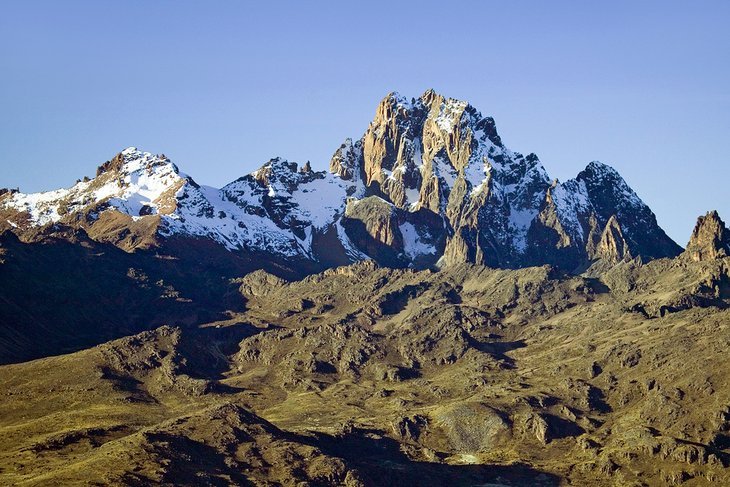
Cool breezes drift across the Indian Ocean to refresh your soul in the country’s many coastal towns and islands. From her highest peaks to her deepest ocean depths, Kenya gives you an African dream trip of a lifetime!
See throngs of wildebeest thundering across the savanna during the Great Migration in the Maasai Mara; come eye-to-eye with an elephant in Amboseli; or marvel at Lake Nakuru, flecked with thousands of flamingos.
In these sun-soaked lands, ancient tribes, such as the Maasai, Kikuyu, and Samburu, retain their traditional customs, living in relative harmony with the natural world.
Beyond the world-famous safari parks lies a trove of coastal treasures. You can snorkel and dive fish-rich coral reefs, relax on pearly beaches, experience the melting pot of cultures and cuisines in Mombasa and Malindi, and explore tropical islands steeped in Swahili history.
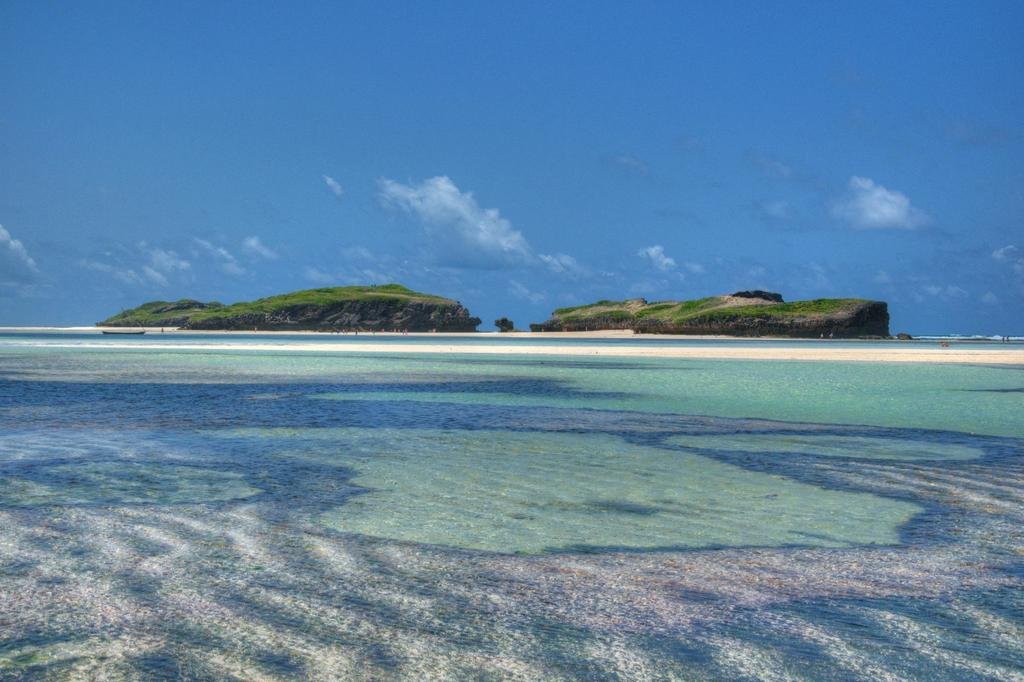
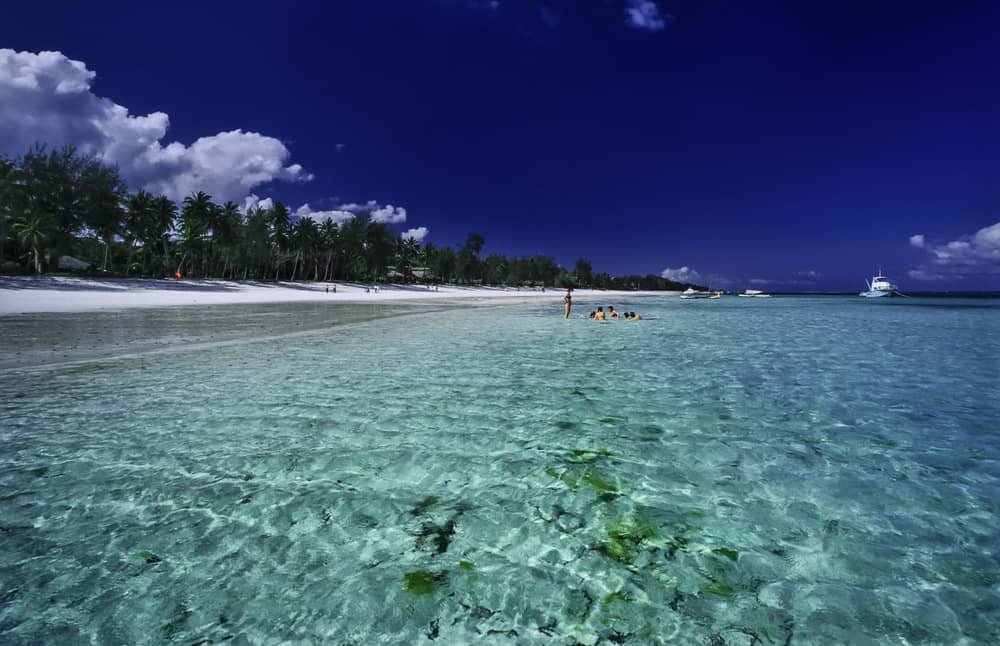
Topographically, Wildlife Safari in Kenya is stunning. Surrounded by calderas and mountain ranges, the Great Rift Valley divides the country. To the east of this sweeping valley, you can climb the snow-cloaked equatorial peaks of Mount Kenya and fish for trout in crystal-clear streams.
Getting to Kenya
Kenya has three international airports; Jomo Kenyatta International Airport in Nairobi, Moi International Airport in Mombasa.
These airports service numerous international carriers including the national airline Kenya Airways. Kenya has good connections to destinations throughout Europe, the Asia- Pacific region, USA and Africa.
Kenya can be accessed by road from Tanzania, Uganda, Ethiopia, Sudan and Somalia. Immigration should be processed at land border stations.
Entry by sea is possible, and immigration should be processed at a port facility.
Flights to and within Kenya:
Kenya Airways ( KQ)
Daily flight arriving to Nairobi from Amsterdam at and 20:55pm supported with connection flight of Air France, KLM and Air Europa which sharing the same Skyteam miles partners.
Daily flight from JFK airport in NY and can be from most destinations in USA and Canada together with DELTA AIRLINE which is part of Skyteam group
Arrive to Nairobi 10:25am
Advantage: Price and very comfortable transit facilities for 30$ in the Business launch in Kigali
Disadvantage: Limited destinations London, Brussels, Tel Aviv near future NY.
Ethiopian Airlines – Daily Flights.
4 Daily flights to Nairobi Arrive at – (01:20 am, 10:25am, 13:30pm, 18:35pm) for starting the Safari first,
2 Flights to Mombasa arrive at – ( 11:30am, 18:00pm) if starting your vacation on Diani beach first.
Advantage to arrive with Ethiopian airlines are;
• Price
• Comfortable arriving hours
• Reliable in time table
• Depart from most major airport in Europe and USA member in Star Alliance therefore can use code sharing with Lufthansa Swiss United Airlines
• Arrive to 2 destinations in Kenya .
Disadvantage:
• Transit facilities are crowded since Ethiopian airlines – Addis Ababa is a big hub of transit
• No business launch facilities for economy class even with a credit card payment
Ethiopian Airlines
Rwanda Air
Arriving to Nairobi from Brussels and Gatwick London 10:35am on Wednesday, Friday, Sunday.
Advantage: Price and very comfortable transit facilities for 30$ in the Business launch in Kigali.
Disadvantage: Limited destinations London, Brussels, Tel Aviv near future NY
Only 3 flights a week
https://www.rwandair.com/
Turkish Airlines
Daily flights, arriving to Nairobi 02:55am.
Advantage:
• Vast origin from the entire world
• Star Alliance member
• Relatively competitive price ( Between Ethiopian to KLM and Swiss)
Disadvantage:
• More expensive then Ethiopian airlines
https://www.turkishairlines.com/
KLM
Arrive daily to Kilimanjaro and Dar Es Salaam and Zanzibar with Kenya Airways as code sharing.
SWISS
Fly Dubai
Dozens of domestic flights a day between the various reserves and cities, mostly 13-seat Cessna aircraft called Caravan like SAFARILINK AIRLINE https://www.flysafarilink.com/
Other Flights.
AIR KENYA https://www.airkenya.com/Daily flights from Nairobi to Diani and Mombasa daily flights
PRECISION AIR and Kenya Airways to Zanzibar or Continue Safari in Tanzania
https://www.precisionairtz.com/
https://www.airkenya.com/
FLYING SAFARI.
Sima Safari builds safari routes where the transition from reserve to air is airy and shortens administrative travel times
From Nairobi or Mombasa to Masai Mara, Amboseli, Samburu, and Lakes.
The Wildlife Safari in Kenya Can be Done in Several Ways:
Dedicated SUVs – The Most Popular Way to Experience the Safari, Suitable for Everyone, Families and Groups.
Safari Land Cruisers crosses gips that can comfortably stay up to 6 people but also 7 casts can be accommodated comfortably.
Toyota van 4X4 to 8 people slows cheaper than the unique and unique to Kenya.
Walking Safaris – There are reserves where you can experience the animals while walking safely, of course. There are no divides between nature and nature in my safari. Good combination with SUVs.
There is a special safari on the island at Lake Naivasha and on the 6 day route of Mount Kenya. You see route here.
7 DAYS MOUNT KENYA TREK(Chogoria Traverse.)
An overnight sight-seeing safari in the Abardare Reserve where guests are being told when elephants, rhinos and other animals arrive at the salt lake at night.
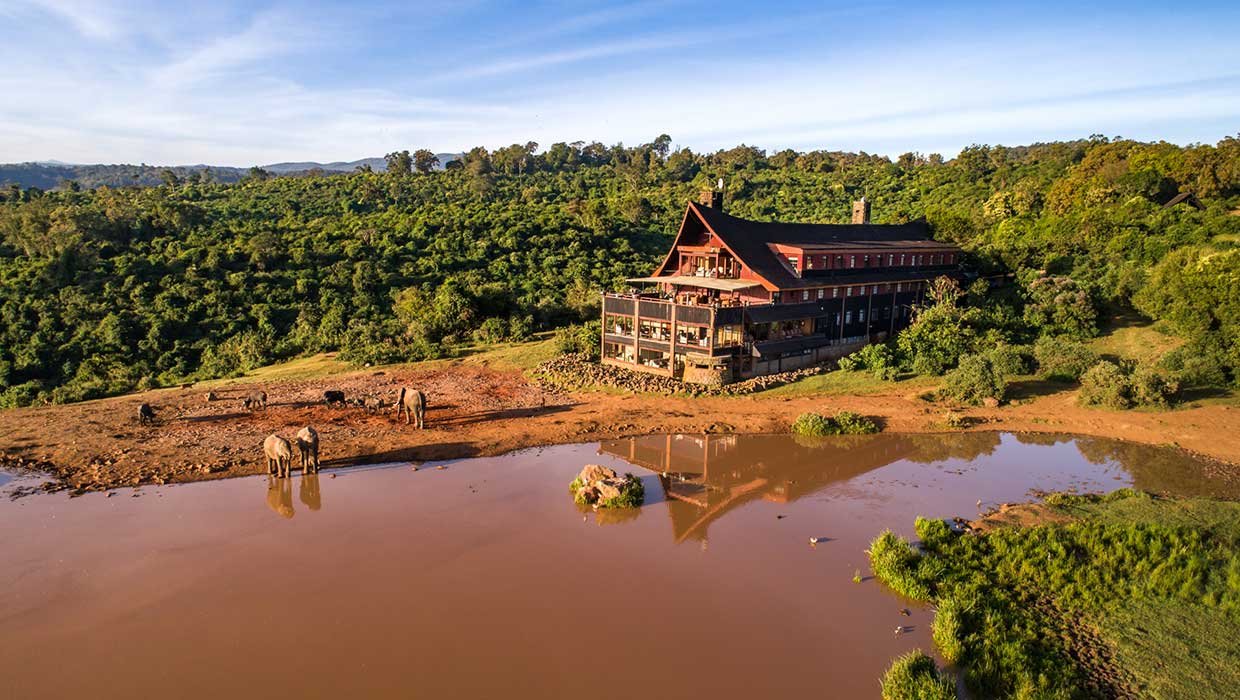
View from the Lodge only
Self-driving.
The route options and the life experiences in Kenya are many. We at Sima Safari, who know every reserve, trail, beach and attraction in East Africa, sew tailor-made safari tours and exotic beaches that are just right for anyone and any family or group according to their wishes and season.
We are planning for you and for you the right dose for you if it is a safari only, a beach resort only and / or a combination of the magical beaches of Kenya or Zanzibar with a fascinating and perhaps safari trek in Mount Kenya.
Once all your route has been decided it is to enjoy the holiday and the safari not to worry about talking, we will take care of all the logistics and experiences.
How to get to the reserves?
Reservations can be reached with both the safari jeep and light aircraft starting from two seats or higher and landing in an area of land that can sometimes be seen as elephant giraffe or antelope herds in lowering and close to the runway. When you land, a safari jeep will always be waiting for you with a guide.
Kenya is very diverse in its goals and the different paths and experiences you personally prefer to experience. From this variety it can be a little confusing to choose the right track for you.
This is also true for other countries in Africa. We plan for you and the right dose for you if it is a safari only, a safari combined with one of East Africa’s summits (see trekking), a beach resort only and / or a combination of Kenya’s or Zanzibar’s magical beaches, and a fascinating Kenya safari trip.
Once all your route has been decided it is to enjoy the holiday and the safari not to worry, we will already take care of all the logistics and experiences from begining to the end.
Getting to the national parks can be done by using both the safari vehicle and flight aircraft starting from two seats or higher and landing in runway with in the national parks and sometimes during the landing can be seen, elephant, giraffes or antelope herds while lowering and close to the runway. At the runway, Sima Safari tour guide and safari car will always be waiting for you equipped with everything you need.
What does a safari vehicle include?
A typical safari vehicle equipped with a refrigerator and sockets for charging electric and portable electric devices.
In a safari vehicle, between 5 and 7 seats for tourists + a driver / guide seat.
Our tour guides are rich in driving experience and familiar with every animal and plant in the area, one that can spot a leopard dangling from a tree in the distance. The rooftop of the car opens and gives a good view of the animals with complete protection. Sima Safari bush lunch are upgrade than standard lunch boxes a hot meal with everything there should be at a proper lunch at the bush , including an unlimited supply of mineral drinking water.
In every Safari Vehicle we have National parks Map with Animal Sets, Swahili English Dictionary and WIFI for all Safari Vehicle Travel Days.
What to Equip Safari?
Lightweight clothing for the heat of the day and warmer clothes for the evenings. High shoes and rubber shoes for walking in creeks and swimming, mosquito protective measures will be helpful.
Mandatory sun protection cream!
Nowadays, no need to say any camera with a high-quality mobile camera will do most of the job fo you can just Focus on quality.
Still, for those of you who love photography, it is unnecessary to mention to bring the camera with various zoom lenses, you will find them very useful.
When to travel?
All year long! What is amazing about Tanzania is that all of its characteristics, herds and predators migrate throughout the year according to food inventions, so that each season we can find them in great concentrations exactly where they feed according to the season for each reserve and its ideal season park. Sima Safari’s guides are experts in finding the animals at any given time.
Even in the rainy season which are the low cost season, April and May it is beautiful and the blooms and landscapes are beautiful and add to beauty of the safari that cannot be experienced in other seasons.
Lodging.
The idea of staying in and around the National parks is to experience nature not only on a daily journey but also at dusk and dusk in preparation for sleep. Experience the roar of animals from the nearby bush and be protected from them, mingle with cheeky monkeys that penetrate the compound in search of a delicious, forgotten snack. The accommodation is in lodges, comfortable and elegant tents or camping.
The lodges in the national parks are forbidden to fence themselves. The choice of accommodation is of course yours. Structural Lodges, are on the bush and blend well into the wild landscape. Tents, don’t worry, there are showers and they look and feel like every quality hotel room.
Most of the accommodations are suitable for every pocket.
How long to spend on safari?
There are National parks with a short distance which can be reached by flight in less than an hour and enjoy the natural habitat of the wild animals and the wild experience. Safaris can be done from day one to two week or even more trips in the Kenya land scape, each one as appropriate. You can also combine different National parks in the same journey by safari vehicle or flying safari and above mentioned.
For the tourists who come mainly to relax on the beaches we have prepared short packages between one day and two nights 3 days safari in various national parks.
Health and Vaccines:
It is not mandatory to vaccinate before arriving to Kenya, but it is advisable to consult a traveling clinic or a treating physician for a recommendation on which vaccines should you apply.
We recommend that you take your vaccine with you
It is mandatory to purchase a suitable medical insurance package in your origin country,
Sima Safari has emergency rescue helicopter insurance for all our travelers for all East Africa (FLYING DOCTOR
Sima Safari, safari vehicles include:
– English speaking guide
– Mineral water bottles in a cooler for all safari days
– Charging points for telephone cables
– One binoculars for your use
– Animal definers
– Map of Kenya National parks
– Swahili / English pocket dictionary
– Air conditioner in vehicles in the Northern Reserves
– first aid bag
– garbage bags
Communication:
Kenya int. Phone code+254
All lodges andc hotels have WIFI connection in public areas and some even in rooms
Call via WHATSAPP is recommended
A local Sim can be purchased, in Arusha City, Zanzibar Airport
Our safari vehicles will have WIFI routers
Charging Phone / Computer:
The electricity in Kenya is 220V with British outlets so it is necessary to have a suitable adapter
It is also advisable to bring a splitter to charge several devices.
Luggage:
The luggage allowance for international flights is 2 luggage of 23 kg each
The allowable weight on domestic flights safari is 15 – 20 kg per single baggage person.
Soft bags up to 20kg,
Suitcase with solid walls 15 kg
Weather and clothing:
The weather in Kenya is enabling traveling all year-round.
In the northern reserves during the day the temperatures reach about 28 degrees (and low humidity percentages) and at night they drop to 18-16 degrees.
From June to September, the nights and mornings are cold, so warm sweatshirts are recommended.
In April and May, rainfall is expected, so it is advisable to have a light rain cape.
Southern National parks and Zanzibar during the day up to 32 degrees and humid and in the evening 22-25 degrees.
In addition, it is worth packing:
• Hat
• Sandals
• Comfortable shoes for walking
• Shoes / sandals for walking in watercourses (non-crocs) or walking in the beach with rocky reef
• Short clothing (summer shirts for the day)
• Long pants and long evening and night shirts
• Swimsuit (Some Lodges have a swimming pool)
• Good sunglasses
• Sunscreen and Mosquito spray
• Additional binoculars and Quality camera.
• Snacks (especially for kids)
Kenyas Top Destinations.
*MASAI MARA NATIONAL RESERVE.(…Read more)
*AMBOSELI NATIONAL PARK(…Read more)
*MOUNT KENYA(…Read more)
*TSAVO EAST AND WEST NATIONAL PARK
(…Read more)
*LAKE NAKURU NATIONAL PARK(…Read more)
*LAKE BOGORIA NATIONAL RESERVE(…Read more)
*SAMBURU NATIONAL RESERVE(…Read more)
*LAKE NAIVASHA NATIONAL RESERVE(…Read more)
*ABARDARE MOUNTAINS NATIONAL RESERVE(…Read more)
*MOUNT ELGON NATIONAL RESERVE(…Read more)
*LAKE BARINGO NATIONAL RESERVE(…Read more)
*KAKAMEGA FOREST NATIONAL RESERVE(…Read more)
View our 12 Days Authentic Safari Package in Kenya
Maasai Mara National Reserve.
Maasai Mara National Reserve (also “Masai Mara”) is one of the world’s most magnificent game reserves. Bordering Tanzania, the Mara is the northern extension of the Serengeti and forms a wildlife corridor between the two countries. It’s named after the statuesque, red-cloaked Maasai people who live in the park and graze their animals here as they have done for centuries. In their language, Mara means “mottled,” perhaps a reference to the play of light and shadow from the acacia trees and cloud-studded skies on the vast grasslands.
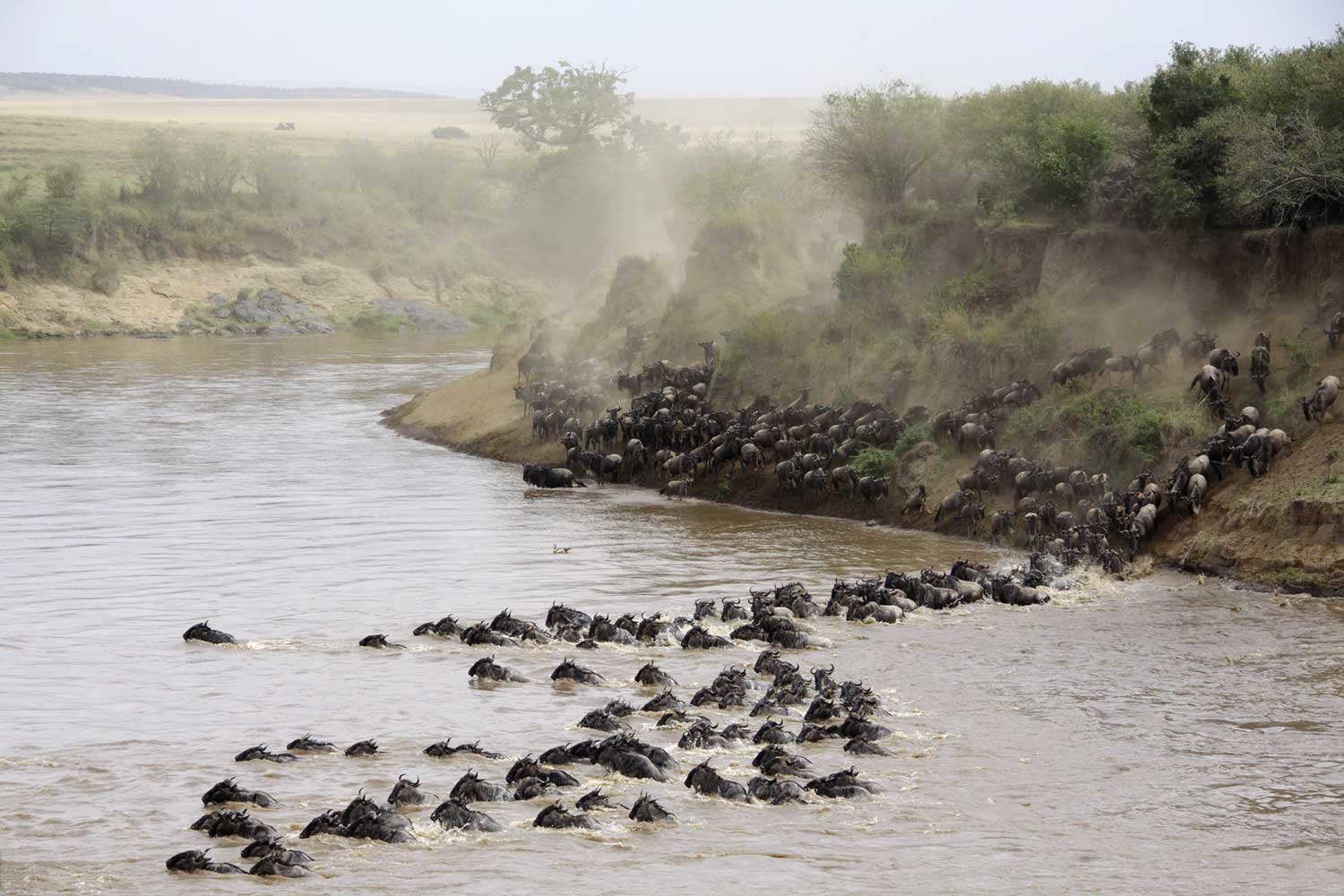
The park is famous for the Great Migration, when thousands of wildebeest, zebra, and Thomson’s gazelle travel to and from the Serengeti, from July through October. In the Mara River, throngs of hippos and crocodiles lurk. The park is also known for providing excellent predator sightings, thanks to its relatively large populations of lion, cheetah, and leopard – especially in the dry months from December through February. Thanks to the park’s altitude, the weather here is mild and gentle year-round.
6 DAYS SAFARI TO ABARDARE, LAKE NAKURU AND MASAI MARA NP
Amboseli National Reserve.
Crowned by Mount Kilimanjaro, Africa’s highest peak, Amboseli National Reserve is one of Kenya’s most popular tourist parks. The name “Amboseli” comes from a Maasai word meaning “salty dust,” an apt description for the park’s parched conditions. The reserve is one of the best places in Africa to view large herds of elephants up close.
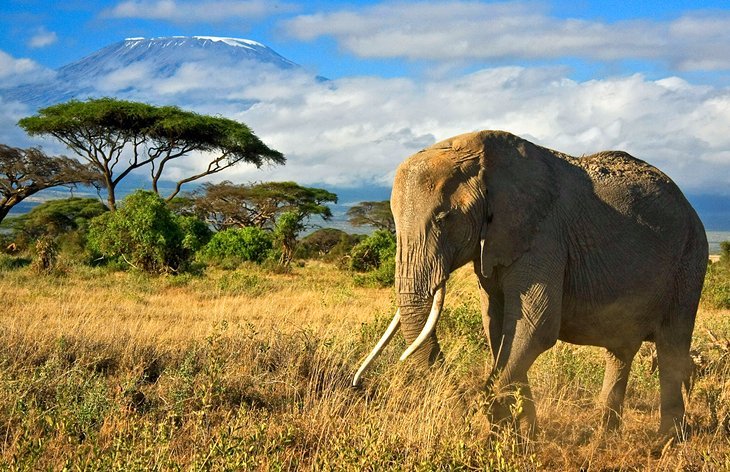
Other wildlife commonly spotted in the park includes big cats, such as lion and cheetah, as well as giraffe, impala, eland, waterbuck, gazelle, and more than 600 species of birds. Nature lovers can explore five different habitats here, ranging from the dried-up bed of Lake Amboseli, wetlands with sulfur springs, savannah, and woodlands. Look for the local Maasai people who live in the area around the park.
Mount Kenya National Park.
In the Central Highlands, east of the Great Rift Valley, Mount Kenya National Park is a UNESCO World Heritage Site encompassing the country’s namesake highest mountain at 5,199 meters and providing the rare sight of equatorial snow. Formed by a series of volcanic eruptions, Mount Kenya is actually comprised of three glacier-cloaked peaks. The highest is Batian, although Nelion, the next highest, is a tougher climb. The lowest peak, Lenana, is considered the easiest climb, although unpredictable weather can pose challenges.

6 DAYS MOUNT KENYA TREK
Scenery varies from glaciers, lakes, and mineral springs to alpine forest and dense pockets of bamboo. The diversity of flora and fauna provides rewarding opportunities for safaris. Among the wildlife here, you may spot black and white colobus monkeys, buffalo, elephant, tree hyrax, leopard, and hyena. Nestled in the foothills, the famous Fairmont Mount Kenya.
Nairobi National Park.
The Nairobi National Park is said to be the only national park within a capital city in the world. This detail makes Kenyan’s particularly proud when talking about Nairobi. It helps that the park is easily accessible, hosts a wide range of animals and is fairly affordable.
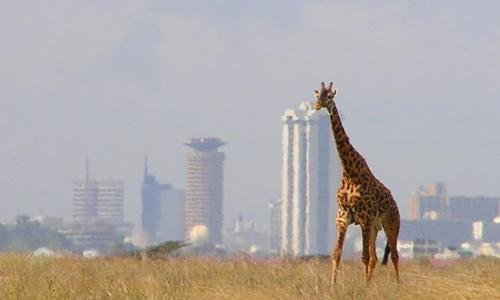
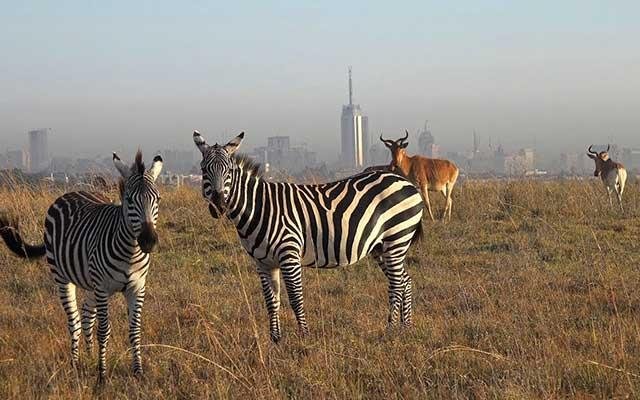
A short drive out of Nairobi’s central business district is the Nairobi National Park. Wide open grass plains and backdrop of the city scrapers, scattered acacia bush play host to a wide variety of wildlife including the endangered black rhino, lions, leopards, cheetahs, hyenas, buffaloes, giraffes and diverse birdlife with over 400 species recorded. Visitors can enjoy the park’s picnic sites, three campsites and the walking trails for hikers.
Tsavo National Park.
Kenya’s largest park, Tsavo, is sliced in two: Tsavo West and Tsavo East. Together these parks comprise four percent of the country’s total area and encompass rivers, waterfalls, savannah, volcanic hills, a massive lava-rock plateau, and an impressive diversity of wildlife.
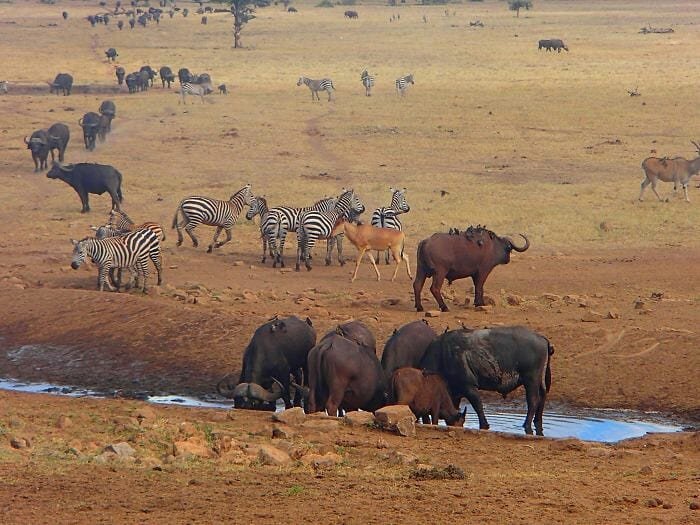
Midway between Nairobi and Mombasa, Tsavo East is famous for photo-worthy sightings of large elephant herds rolling and bathing in red dust.
Tsavo West is wetter and topographically more varied, with some of the most beautiful scenery in the northern reaches of the park.
Lake Nakuru National Park.
Lake Nakuru National Park, in Central Kenya, is famous for its huge flocks of pink flamingos. The birds throng on Lake Nakuru itself, one of the Rift Valley soda lakes that comprises almost a third of the park’s area.

The park was established in 1961, and more than 450 species of birds have been recorded here, as well as a rich diversity of other wildlife. Lions, leopards, warthogs, waterbucks, pythons, and white rhinos are just some of the animals you might see, and the landscapes range from sweeping grasslands bordering the lake to rocky cliffs and woodland.
7 DAYS SAFARI TO MASAI MARA, LAKE NAKURU AND AMBOSELI NP
Kenyan Birding Safari.
From the world’s biggest bird, the Ostrich, to spectacular flamingos that congregate in their millions at the various Lakes of the Great Rift Valley and camouflage them in pink, Kenya holds some remarkable birding sights that you have to see them to believe. With eleven percent of the world’s species – some 1089 different varieties, Kenya’s birding is one of the best in the world. It is not unusual for birding trips to record 300-600 different varieties on a short trip or to record more than 120 at a particular site on a single day!

The variety of birds in Kenya is made possible by the favorable climate, diverse habitats and geographical features that make it a suitable migratory route for birds. Even without venturing outside Nairobi, Kenya’s capital, more than 600 resident and migratory bird species are found; more than in any other capital city, and more than in most countries.
Mombasa.
Kenya’s second largest city and biggest port, Mombasa is a multicultural tourist magnet. British, Portuguese, Arab, Indian, and Asian immigrants add to the rich cultural mix, and their influence is evident in the architecture, as well as the many different types of cuisine. Mombasa is actually an island connected to its mushrooming development on the mainland by a causeway, bridges, and ferries. Coral reefs fringe the coast for 480 kilometres providing fantastic snorkeling and diving opportunities, especially at Mombasa Marine National Park and around Wasini Island. Dolphin watching and deep-sea fishing are also popular.

History buffs will enjoy exploring the 16th-century Fort Jesus and Old Town with its narrow streets, ancient Swahili dwellings, markets, and souvenir shops.
The north shore of Mombasa is crammed with attractions including Mombasa Go-Kart, cinemas, sports, and a cornucopia of restaurants. This being a coastal hub, beach lovers will find some worthy strands nearby. North of the city, Nyali and Bamburi Beaches are favorites, while the white strands of Shelly, Tiwi, and Diani Beaches are popular spots south of Mombasa.
Diani Beach.
Diani Beach is the place to go. A fantastic long white beach with loads of watersports and primates to see. A night at ’40 Thieves’ beach bar is a great place to hang out with a few tuskers (beers).

6 DAYS ALONG THE ENCHANTING DIANI BEACH.
If you want to see one of the six primate species in South Coast Kenya visit the Colobus Trust, dedicated to primate rescue, research and conservation, for an informative walk and you may spot one of the many wild primates.
Photo:
There is a lot to photograph in Kenya, landscapes, animals, people, sunsets, sunrises, beaches and nature in its glory
So it is best to have a high quality camera in addition to the mobile phone
If you want to photograph people – ask permission and respect their wishes
It is recommended to come with additional memory cards, there will be many photos, including video
Bring extra batteries, the batteries can be recharged in the vehicle
Children:
On a family safari trip with children, you should bring some snacks from your origin country which the children familiar with and love, in order to be backed up In addition to the lunch you receive, there is no supermarket in the middle of the safari.
Cool Parties and Nightlife
Kenyans love to have a good time and party, especially after work and on weekends. The number of bars and clubs in cities that are full of life regardless of the day of the week only goes to support this. Kenyans throw cool parties amongst friends and family, and these parties enhance a sense of togetherness.
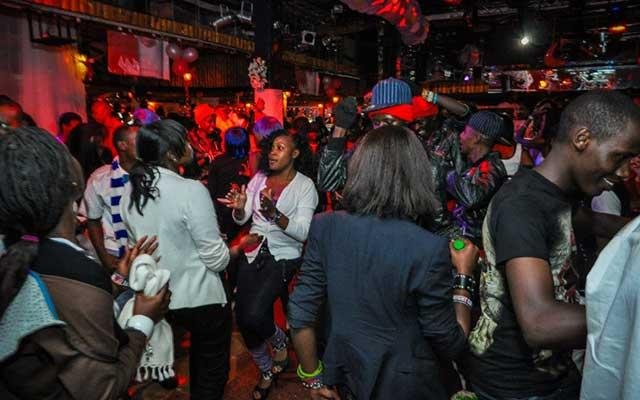
Tusker
Tusker is a beer brewed in Kenya by a subsidiary of DIAGEO. It is made from locally obtained ingredients and has over the years been identified as Kenya’s beer brand. It is a popular beer in Kenyan meetups and events and now comes in a range of varieties including Malt, Lite, and Cider. Even teetotalers will agree that Tusker is one of those brands that are uniquely Kenyan.
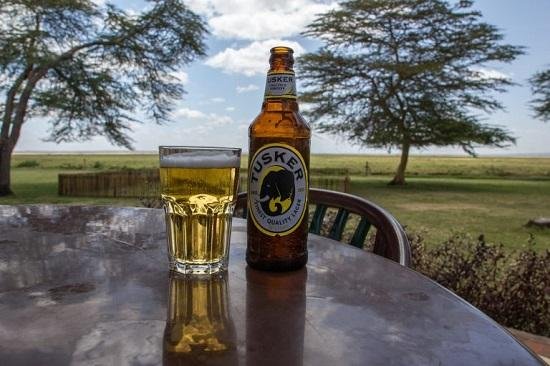
12 DAYS AUTHENTIC SAFARI IN KENYA
Other Useful link for a wildlife Safari in Kenya.
Magical kenya
Kenya Tourism Federation
Ministry of Tourism, Kenya
Kenya Wildlife Service
Kenya Association of Tour Operators(KATO)
Masai Mara National Reserve
Amboseli National Park

